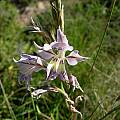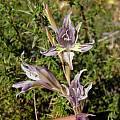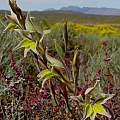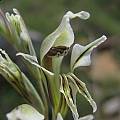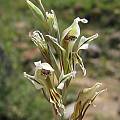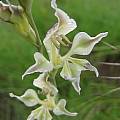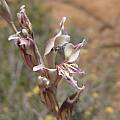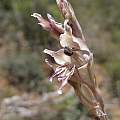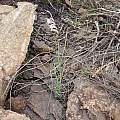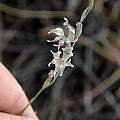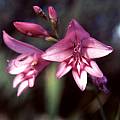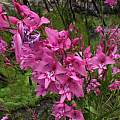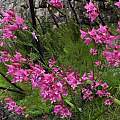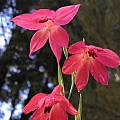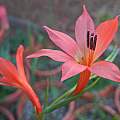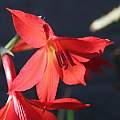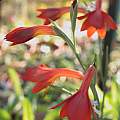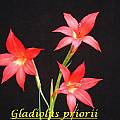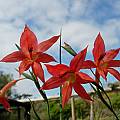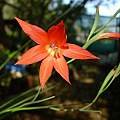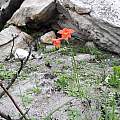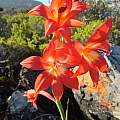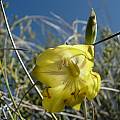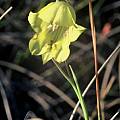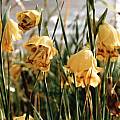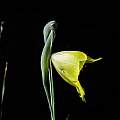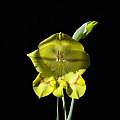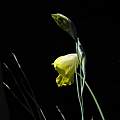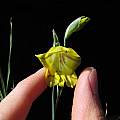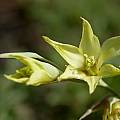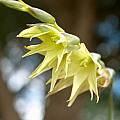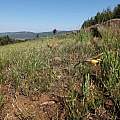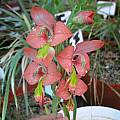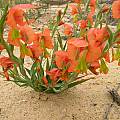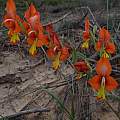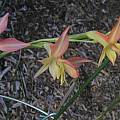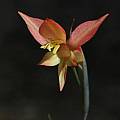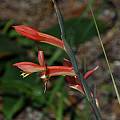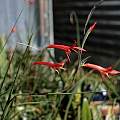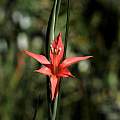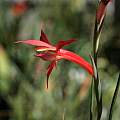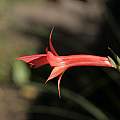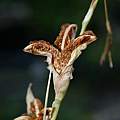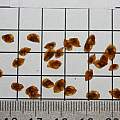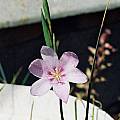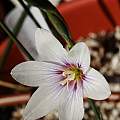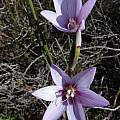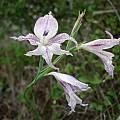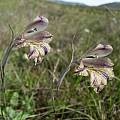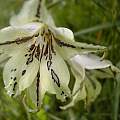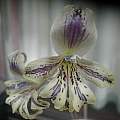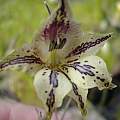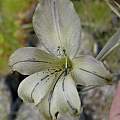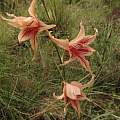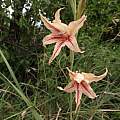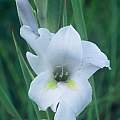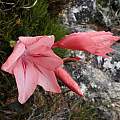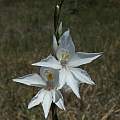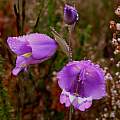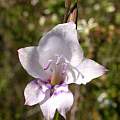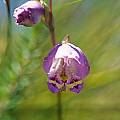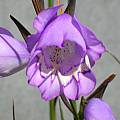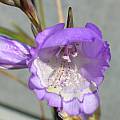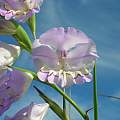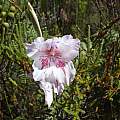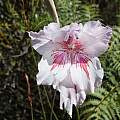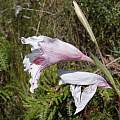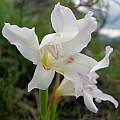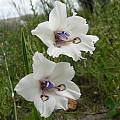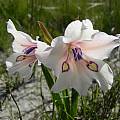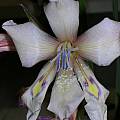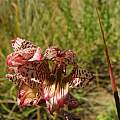There are about 163 species of Gladiolus (with new ones being discovered) in the area south of the Tropic of Capricorn and including Botswana, Lesotho, Namibia, South Africa, Swaziland, and Mozambique. Some are found in winter rainfall areas and some in summer rainfall areas. For more information see Goldblatt and Manning, 1998. Southern African species from Pe-R are pictured on this page.
Gladiolus index - Southern African gladiolus A-B - Southern African gladiolus Ca - Southern African gladiolus Ce-E -- Southern African gladiolus F-H - Southern African gladiolus I-Me - Southern African gladiolus Mi-Pa - Southern African gladiolus S-T - Southern African gladiolus U-Z - Gladiolus Hybrids - Miscellaneous gladiolus
Gladiolus permeabilis D.Delaroche grows on shale slopes in renosterveld from Caledon east through southern Africa and to Zimbabwe. In the Cape province it blooms late winter into spring, usually growing 20-30 cm tall, but can be seen up to 50 cm. Plant has flat narrow leaves with a prominent midrib and mauve to dull purple or cream flowers with yellowish makings. Flowers are usually intensely fragrant. The first photo was taken by Cameron McMaster in the Overberg and the second by Bob Rutemoeller in the Bontebok National Park. The last photo below from the book Plants of the Klein Karoo courtesy of Jan and Anne Lise Schutte-Vlok
Gladiolus permeabilis ssp. edulis (Burch. ex Ker Gawl.) Oberm., syn. Gladiolus edulis, is widespread across the summer-rainfall zone and is common in the drier areas. This subspecies has whitish to cream, sometimes grey or mauve flowers. All of the tepals except for the dorsal have a grey to purple or maroon midline sometimes surrounded by a yellow streak. The lower lateral tepals are yellow in the upper half. Tepals have an elongated and tapering tip or tail-like twisted and undulate appendages. Photos taken by Cameron McMaster in two locations in the Eastern Cape.
The photos below were taken at Andriesberg by Cameron McMaster and Bob Rutemoeller in January and February, different years.
Gladiolus phoenix Goldblatt & J.C.Manning is a rare local endemic restricted to moist backs and ravines in the Bain's Kloof Mountains. This plant appears to need fire to stimulate bloom. Flowers are pink with a white spear shaped mark outlined in deep pink on the lower three tepals. Height range: 50-75 cm. The first photo by Alan Horstmann. The next two were taken by Rachel Saunders post fire near Bainskloof, November 2015.
Gladiolus pillansii G.J.Lewis see Gladiolus martleyi
Gladiolus primulinus Baker see Gladiolus dalenii
Gladiolus priorii (N.E.Br.) Goldblatt & M.P.de Vos (syn. Homoglossum priorii (N.E.Br.) N.E.Br.) is a fall blooming species (April to June) found on sandstone and granite slopes in the Southwestern Cape, South Africa. Growing from 30 to 40 cm high, it has leathery linear leaves and tubular red flowers with yellow throats in a one to four flowered spike. They droop slightly, making it hard to see the centers unless you crouch down. It is considered relatively easy to grow in captivity, although Mary Sue Ittner has found in her Northern California coastal garden that it is short lived and has to be started regularly from seed. The first photo from Bob Rutemoeller shows a plant growing in the ground, flowering in November. The second photo was taken by Mary Sue Ittner, the third by Alan Horstmann, the fourth by Michael Mace, and the last by Bill Dijk.
The first two photos were taken by Cameron McMaster. The last two photos were taken by Rachel Saunders. The first of these was taken June 2011 of this species blooming on Table Mountain in the southwestern Cape in an area that had previously burned and the second in Hermanus.
Gladiolus pritzelii Diels is found on rocky sandstone slopes in the northwest Cape. It has bell-like yellow flowers with red to brown transverse markings on the lower tepals. Height: 30-50 cm. The first photo was taken by Cameron McMaster on Ouberg Road in the Roggeveld and the second by Rod Saunders from Silverhill Seeds. The flowers have a mild scent of green apples.
The photos below are of plants in cultivation. Photo 1 was taken by Alan Horstmann, and photos 2-5 were taken by Nhu Nguyen.
Gladiolus psittacinus Hook.f. see Gladiolus dalenii
Gladiolus pubigerus G.J.Lewis syn. Gladiolus pugioniformis Hilliard & B.L.Burtt has a strange distribution pattern. It is found in the Eastern Cape and in some areas of KwaZulu-Natal, and then in the mountains of Mpumalanga. It has pale lemon yellow flowers tinged with green and flowers in spring. Height range: 30-50 cm. The plants in Mpumalanga are a bit different than those in the Eastern Cape. It flowers well after a fire and not as well in between. The first two photos were taken by Cameron McMaster. The last photo was taken by Rachel Saunders September 2014 in habitat in Mpumalanga near Lydenburg, at an altitude of about 1800 m. It was flowering in a fire break around a pine plantation which was burned sometime in the winter. The area had a small amount of rain in August, and this was obviously enough to stimulate a few plants to flower.
Gladiolus pulcherrimus (G.J.Lewis) Goldblatt & J.C.Manning has very striking orange to salmon flowers that are similar to Gladiolus alatus but is distinguished by broad sword shaped leaves that lack prominent veins. It grows in the northwest Cape on sandstone slopes. Height range: 20-60 cm high. The first photo from Bob Rutemoeller is of a plant grown by Gordon Summerfield in South Africa, which was blooming September 2003. The next two photos by Alan Horstmann, and Rod Saunders.
Gladiolus punctulatus Schrank see Gladiolus hirsutus
Gladiolus quadrangularis (Burm.f.) Ker Gawl. (syn. Homoglossum quadrangulare) is found on rocky sandstone slopes in the Northwest Cape. It has 4 to 10 red to orange flowers and blooms late winter into spring. Height range: 50-90 cm tall. Photos 1-3 were taken by Mary Sue Ittner showing plants that bloomed in Northern California March 2004 and 2007.
The photos below were taken by Nhu Nguyen. The seeds are on a 1 cm grid.
Gladiolus quadrangulus (D.Delaroche) Barnard (syn. Ixia linearis, G. linearis, G. biflorus) is found in the southwestern Cape in sandy soil in seasonally wet, poorly drained and sometimes brackish habitat. Goldblatt & Manning report that it has been eliminated from most of its original range, and that "its long-term survival in the wild is unlikely." Fortunately, it is relatively easy to grow in cultivation, where it can be treated like a typical winter-growing Glad. It has pale pink, mauve or white flowers. The tepals have darker veins. It blooms late winter into spring. The shape of the flowers is reminiscent of an Ixia, and unlike most Gladiolus it does not produce nectar. Goldblatt & Manning speculate that it is adapted to pollination by pollen-eating insects. Height range: 14-35 cm high. First photo by Alan Horstmann. Second photo by Michael Mace of a plant whose name tag was lost, but which is almost certainly G. quadrangulus. The final photo was taken by Rachel Saunders who photographed it in the wild.
Gladiolus recurvus Linnaeus occurs in shale derived soils from Ceres to Bredasdorp and flowers from June to October depending on the elevation. The fragrant flowers are pale gray to cream, yellowish or pinkish with purple lines and dots on the lower tepals and sometimes spotted or lined in the midline on the upper tepals as well. Height: 25-35 cm. The first two photos were taken by Cameron McMaster in the Overberg. The other photos by Dirk Wallace show variation in the markings on flowers.
Gladiolus reginae Goldblatt & J.C.Manning is a rare species known from only two populations where plants grow in open woodland in rocky outcrops, partially shaded by shrubs and trees, in heavy metal-enriched soils. Growing from .4 to 1.5 m, it has 7 to 16 unscented long tubed flowers in an erect spike. Flowers are pale flesh-pink flushed deeper salmon and the lower three tepals are flushed deep red in the basal third with longitudinal lines. The upper three tepals are flushed deep red at the base. Flowering takes place from mid March to mid April, but may skip a year if it's too dry. Goldblatt and Manning report that flowers are pollinated by long-proboscid flies, but also attract ants with sweet droplets from the tips of the bracts, likely for protection from other insects.
Photos by Rachel Saunders shows specimens found in the Blyde River Canyon Nature Reserve (situated in Mpumalanga).
Gladiolus rehmannii Baker is a summer rainfall species that grows in sandy soils, often in rocky ground in light woodland in the northern part of South Africa to eastern Botswana. Growing from 30 to 50 cm, it has white to pale lilac flowers with yellow nectar guides and is unscented. It blooms from mid January to March. Photo from Rod Saunders.
Gladiolus rhodanthus J.C. Manning & Goldblatt is distributed on rocky sandstone slopes at high elevations in the southwest Cape. Growing from 30 to 50 cm, it has hairy linear leaves and pink flowers with red markings on the lower tepals. Photo by Rachel Saunders taken with some effort since it was quite a climb (in light rain/mist) to get to it. It was growing at 1700 m in cracks in the cliffs.
Gladiolus robertsoniae F.Bolus is a summer rainfall species endemic to a small area in the highveld of southern Mpumalanga and the Free State South Africa where it grows in rocky sites, mostly dolerite outcrops, where corms are wedged in crevices and therefore protected from predators. Sites are restricted to areas that stay wet longer such as seeps or streambanks. Plants grow from 20 to 40 cm high. Plants flower at the end of the dry season (mostly October, but sometimes later). A species of section Hebea, it has large white long tubed flowers with fine red lines at the base of the lower tepals. Flowers are sometimes flushed light mauve on fading and are fragrant, scented of carnation day and night. Photo from Rachel Saunders.
Gladiolus robustus Goldblatt see Gladiolus geardii
Gladiolus rogersii Baker grows to 60 cm and has narrow leaves with a prominent midrib. Flowers are blue to purple with yellow or white transverse markings on the lower tepals. In the Kammanassie Mountains flowers can be cerise-pink. This is a widespread South African species found on sandstone and limestone slopes in winter and year round rainfall areas and mostly blooms in spring. There are variants that flower from autumn to early winter on the foothills of the mountains in the Little Karoo. The first two photos and information from the book Plants of the Klein Karoo courtesy of Jan and Anne Lise Schutte-Vlok. The third photo by Mary Sue Ittner was taken of a plant growing on a slope east of Swellendam. Most of the flowers had been eaten by an insect. Photos 4-6 were taken by Alan Horstmann.
Gladiolus roseovenosus Goldblatt & Manning is a rare winter rainfall species that grows in peaty sandstone soil on well drained slopes in the coastal foothills of the Outeniqua Mountains in the southern Cape. Plants grow 20 to 40 cm high and the long tubed creamy pink unscented flowers with red nectar guides are in a 2 to 4 flowered spike. Blooming time is summer into fall, between February and April. Photos taken by Rachel Saunders.
Gladiolus rudis Licht. ex Roem. & Schult. grows on sandstone slopes in fynbos in the southwestern Cape and blooms in spring. It has 2 to 5 cream to pale pink flowers on a spike. The lower tepals have spear-shaped markings and the perianth tube is funnel shaped. Height range: 20-50 cm. The first three photos taken by Cameron McMaster near Caledon and Fairfield in the Overberg and the last taken by Alan Horstmann.
Gladiolus rufomarginatus G.J.Lewis is a summer-growing species with a narrow distribution in the Lydenburg area of Mpumalanga where it grows in grassland in open or shade on stony shale ground and sometimes in crevices in bare shale outcrops. It has long and slender leaf blades with margins and midrib strongly thickened and raised. Flowers are cream to pale straw and densely speckled with small, dark red spots. Bracts are pale and dry at anthesis and slightly transparent flushed with pink and with rusty brown margins. Height range: 30-50 cm. Photo taken by Rachel Saunders. In habitat it flowers March to April, sometimes in May.
Gladiolus index - Southern African gladiolus A-B - Southern African gladiolus Ca - Southern African gladiolus Ce-E - Southern African gladiolus F-H - Southern African gladiolus I-Me - Southern African gladiolus Mi-Pa - Southern African gladiolus S-T - Southern African gladiolus U-Z - Gladiolus Hybrids - Miscellaneous gladiolus
